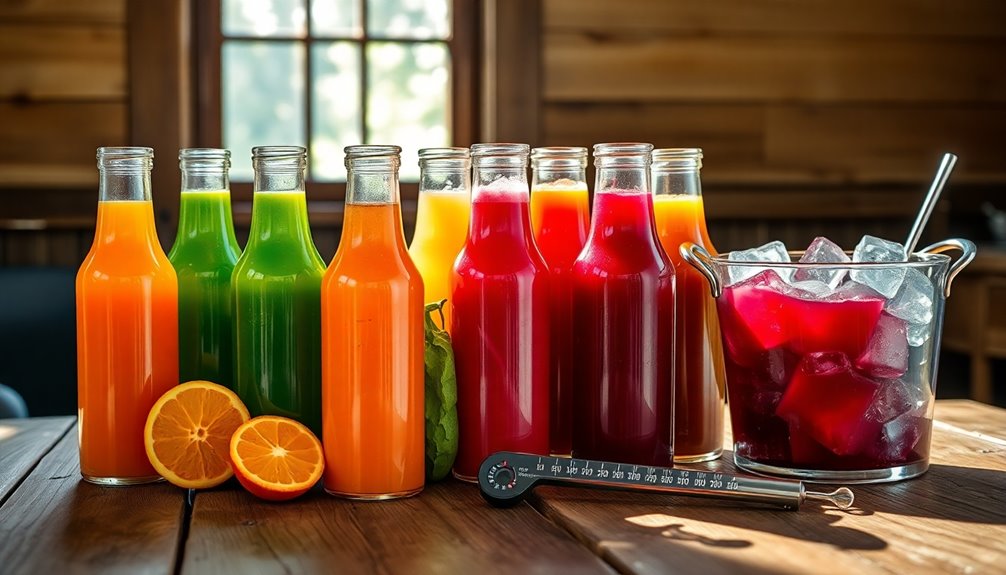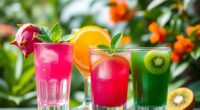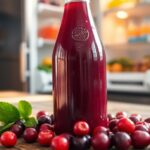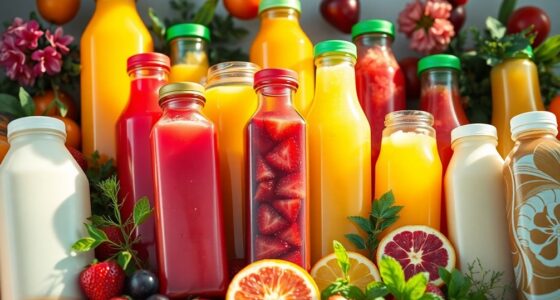To keep your juices fresh and safe, always refrigerate them at 34-40°F. Consumed within 2 days after opening is best, but unopened juice can last 1-2 weeks. Pay attention to the packaging; glass provides better protection than cartons. Watch for spoilage signs like odor changes or discoloration. You can extend cold-pressed juice shelf life by freezing or adding natural preservatives. Discover more innovative techniques to preserve your juice's freshness and flavor!
Key Takeaways
- Store juices at 34-40°F (1-4°C) to maximize freshness and slow microbial growth.
- Consume opened cold-pressed juices within 2 days for optimal safety and flavor.
- Avoid leaving juices unrefrigerated for more than 8 hours to retain Vitamin C and prevent spoilage.
- Use airtight containers to minimize air exposure and protect juices from light and heat.
- Regularly check for signs of spoilage, including discoloration, off odors, and sedimentation, to ensure safety.
Importance of Refrigeration for Juice
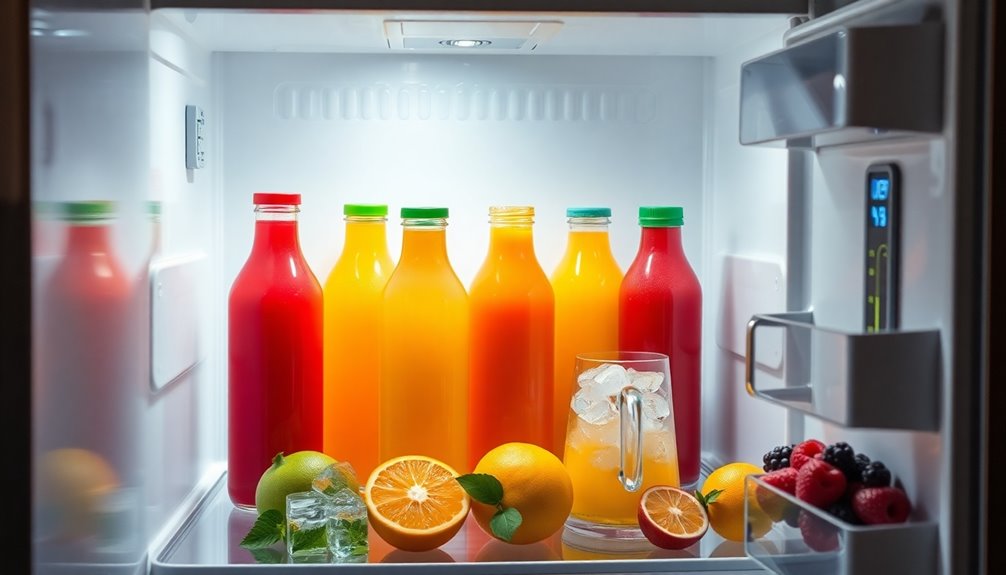
When it comes to preserving the freshness and safety of your juice, refrigeration is non-negotiable. Keeping your juice at 40°F (4°C) or lower is crucial for effective temperature control, as it markedly slows microbial growth.
For opened bottles, aim to consume cold-pressed juices within 7-10 days to guarantee quality and minimize spoilage risks. If you leave juice at room temperature, drink it within 8 hours—after that, you could lose up to 50% of Vitamin C.
Proper storage means sealing your juice tightly and placing it away from strong odors in the fridge. This practice not only helps maintain its taste but also protects against food safety issues, especially with unpasteurized juices that carry a higher risk of foodborne illness.
Role of Pasteurization in Juice Safety
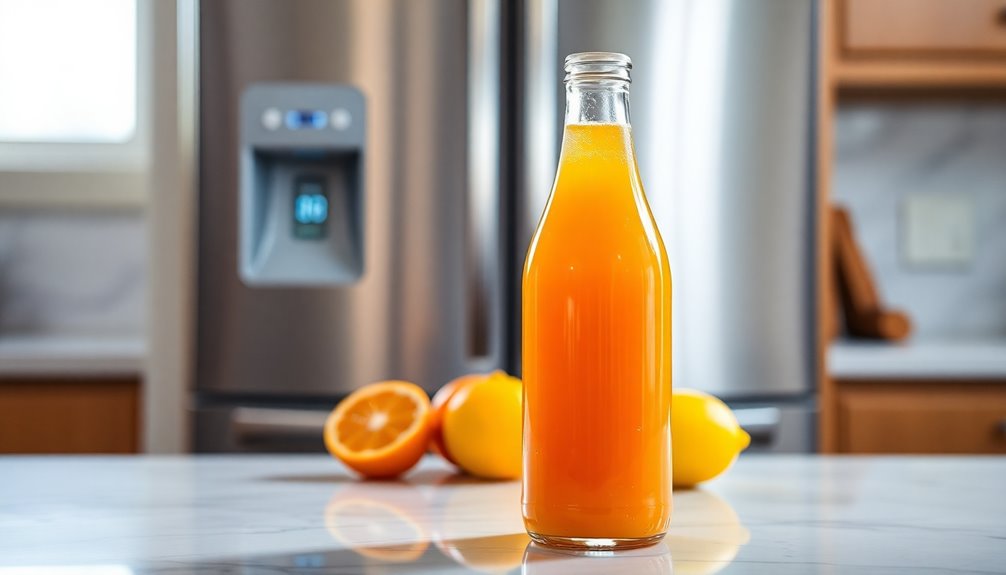
When it comes to juice safety, pasteurization plays a vital role in protecting you from harmful bacteria.
By heating juice to specific temperatures, it not only kills pathogens but also helps preserve essential nutrients and flavors.
Understanding the benefits of pasteurization can guide your choices, especially when considering the risks associated with unpasteurized juices. Additionally, fresh juices, particularly those made from organic fruits and vegetables, are more susceptible to bacterial contamination if not properly handled.
Benefits of Pasteurization
Pasteurization plays an essential role in guaranteeing juice safety by effectively killing harmful bacteria, which greatly reduces the risk of foodborne illnesses.
By using pasteurization, you not only enhance the safety of your juice but also extend its shelf life. This process allows juices to remain unrefrigerated until opened, making storage and transportation much more convenient.
Flash pasteurization, in particular, is preferred as it maintains more nutrients and flavor compared to traditional methods.
However, unpasteurized juices carry a higher risk of foodborne illness, so proper temperature control is imperative for their safety.
Nutrient Preservation Techniques
One key technique for preserving nutrients in juice involves the application of pasteurization, which effectively balances safety and quality.
This process kills harmful bacteria, greatly enhancing the safety and shelf life of your juice. With methods like flash pasteurization, you can enjoy a beverage that retains more nutrients and flavor.
Unlike unpasteurized juices that require refrigeration and must be consumed quickly, pasteurized juices can remain unrefrigerated until opened, giving you more flexibility in proper food storage.
While pasteurization extends the shelf life by several days, it's essential to recognize that it may reduce probiotic content. Additionally, beet juice offers numerous health benefits, including improved blood flow and enhanced exercise performance.
Nevertheless, for safe and nutrient-rich juice, pasteurized options are a smart choice.
Risks of Unpasteurized Juices
While the appeal of fresh, unpasteurized juice is strong, it is crucial to understand the risks associated with consuming it. Unpasteurized juices can harbor harmful bacteria like E. coli and Salmonella, leading to foodborne illnesses. These pathogens thrive in raw juices, making safety a concern. While you can refrigerate these juices to extend their shelf life, this method isn't foolproof. In contrast, pasteurization effectively kills harmful microorganisms, improving safety and allowing pasteurized juices to be stored unrefrigerated until opened. Additionally, pasteurized juices may offer a safer option without significantly compromising their nutritional value.
| Aspect | Unpasteurized Juices | Pasteurized Juices |
|---|---|---|
| Safety | Higher risk of illness | Much safer |
| Shelf Life | Shorter | Longer |
| Refrigeration Needed | Yes | No (until opened) |
| Nutritional Value | Preserved | May lose some nutrients |
Different Juice Packaging and Shelf Life
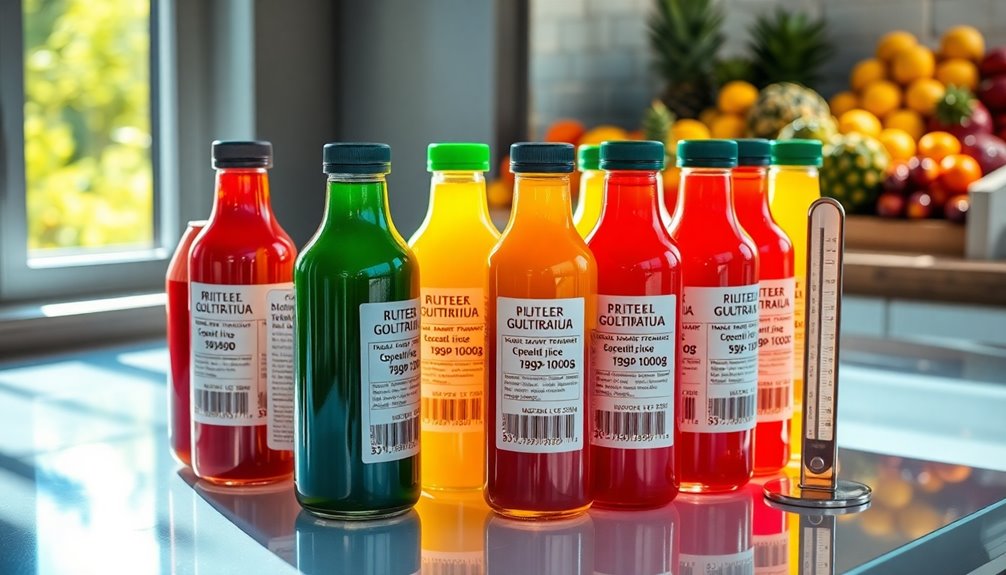
When it comes to juice packaging, your choice can greatly affect its shelf life. Glass bottles offer superior protection against light and air, while aseptic cartons allow for room-temperature storage until opened. Understanding these options helps you make informed decisions about how to keep your juice fresh longer. Additionally, juice quality can be maintained by storing it at optimal temperatures to prevent spoilage.
Packaging Types Explained
Understanding the different types of juice packaging is vital for maintaining freshness and safety.
You'll often encounter glass bottles and BPA-free plastic containers for refrigerated juices. Glass bottles typically offer better protection against light, which can compromise juice quality.
For those who prefer shelf-stable options, aseptic packaging is the way to go. These cartons and cans keep juice safe at room temperature until opened, making them convenient for your pantry.
Regardless of the packaging type, remember that unopened juices generally last 1-2 weeks in the fridge, and all juices must be refrigerated after opening. This step is critical to inhibit microbial growth and guarantee your juice stays fresh and safe to drink. Additionally, choosing juices with fresh ingredients can significantly enhance both flavor and nutrition, ensuring a healthier experience.
Shelf Life Considerations
Choosing the right packaging for your juice not only affects its freshness but also its shelf life. Understanding how different types of juice packaging impact longevity can help you maintain quality. Here are key considerations:
- Cold-pressed juices: Refrigerate at 40°F (4°C) or lower; last 2 days after opening.
- Shelf-stable juices: Safe at room temperature until opened; lasts 1-2 weeks in the fridge post-opening.
- Unopened pasteurized juices: Can be unrefrigerated briefly; consume within 7-10 days after opening.
- Clear vs. opaque containers: Clear bottles expose juice to light, degrading quality faster. Additionally, fresh lemon juice typically lasts 2-3 days in the fridge, highlighting the importance of proper storage to maximize freshness.
Refrigeration Requirements by Juice Type
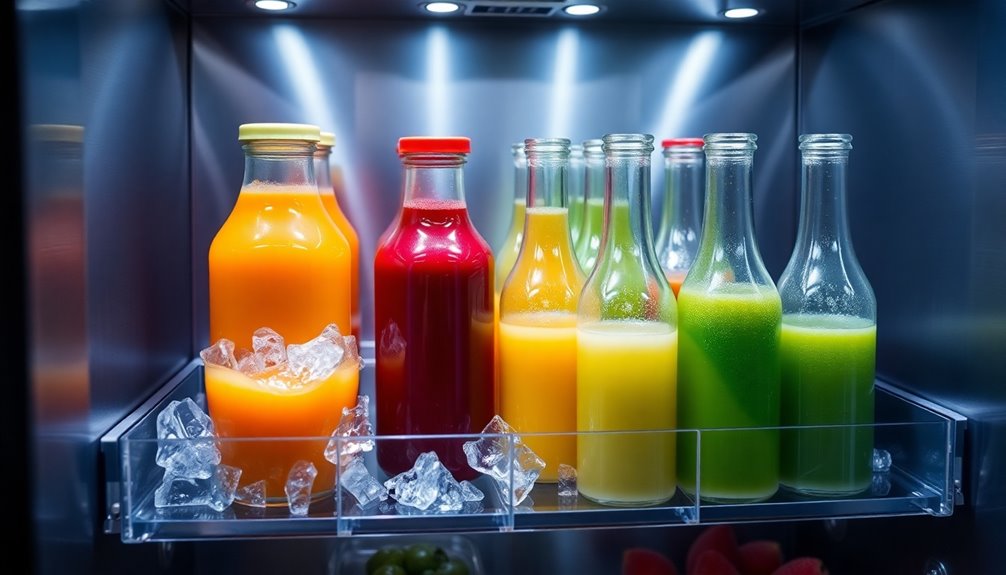
Different types of juices have specific refrigeration requirements that are essential for maintaining their quality and safety. For instance, freshly squeezed juices should be consumed within a few days and stored at temperatures below 40°F to prevent harmful bacteria growth. On the other hand, pasteurized juices have a longer shelf life but still require proper refrigeration to ensure they remain fresh and flavorful. Investing in the best machines for juice production can also help preserve the nutrient content and taste of the juices, enabling enthusiasts to enjoy high-quality beverages while adhering to safe storage practices.
Cold-pressed juices should be stored in the refrigerator at temperature ranges between 34-40°F to enhance shelf life and prevent microbial growth, ideally consumed within 2 days.
Green juices often last longer than fruit-based blends due to lower sugar content, which helps reduce spoilage.
After opening, make certain you consume most juices within 7-10 days for proper food safety.
If you leave cold-pressed juices unrefrigerated, try to drink them within 8 hours, as nutritional value drops quickly.
High-pressure processed juices can stay fresh for over 10 days, while unpasteurized juices require constant refrigeration to guarantee safety.
Follow these storage tips for peak enjoyment!
Signs of Juice Spoilage
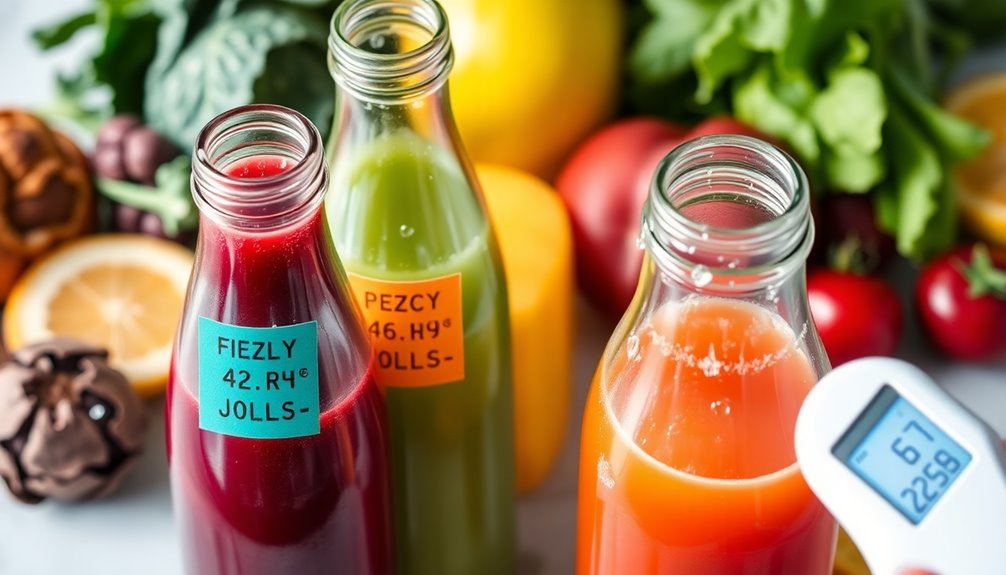
While enjoying your juice, it's crucial to be aware of the signs of spoilage that can compromise both its taste and safety. Spoilage can occur due to improper juice storage or temperature fluctuations.
Here are key indicators to watch for:
- Oxidation: Look for separation with brown foam or sedimentation of pulp.
- Color Change: A grayish or dull hue signals that the juice may no longer be safe.
- Odor: Strong fermented smells suggest bacterial growth; it's best to discard the juice.
- Taste Test: Off, sour, or fizzy flavors indicate spoilage, and mold development on the surface is a definitive sign to throw it away.
Additionally, understanding the importance of proper storage can significantly extend the freshness of your juice. Stay vigilant to guarantee your juice remains fresh and enjoyable!
Tips for Increasing Cold Press Juices Shelf Life
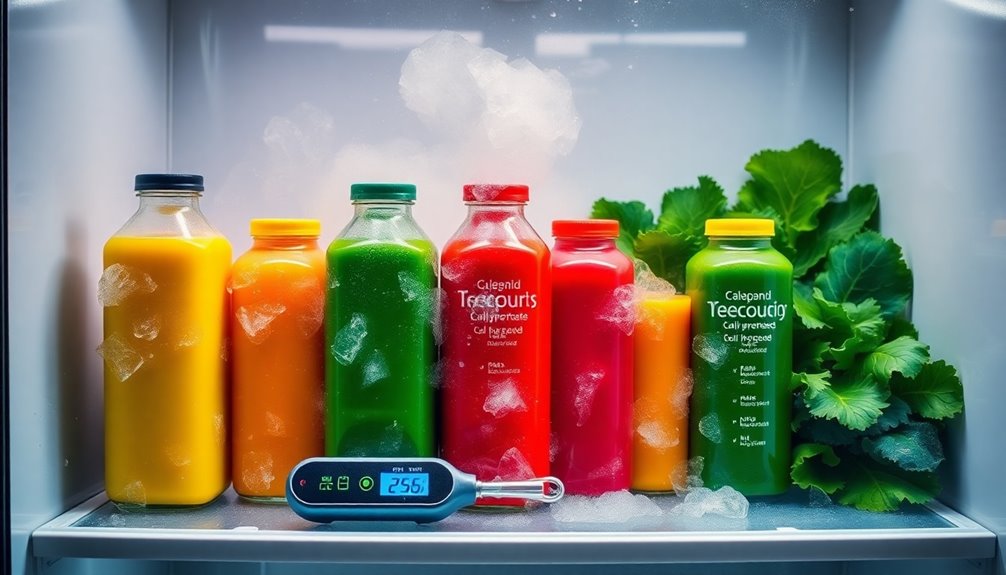
To guarantee your cold-pressed juices stay fresh for as long as possible, proper storage and attention to temperature are essential.
Store your juices in the refrigerator between 34-40°F; this can maximize their shelf life to about 2 days.
For longer storage, consider freezing your juices in airtight containers—this can extend shelf life to 6-12 months.
Adding natural preservatives like lemon juice or vitamin E can also help, keeping your juices fresh for 3-5 days.
Avoid leaving your cold-pressed juice unrefrigerated for more than 8 hours, as nutrients degrade quickly.
If available, high-pressure processing can extend refrigerated shelf life by over 10 days while preserving taste and nutrition.
Best Practices for Juice Storage
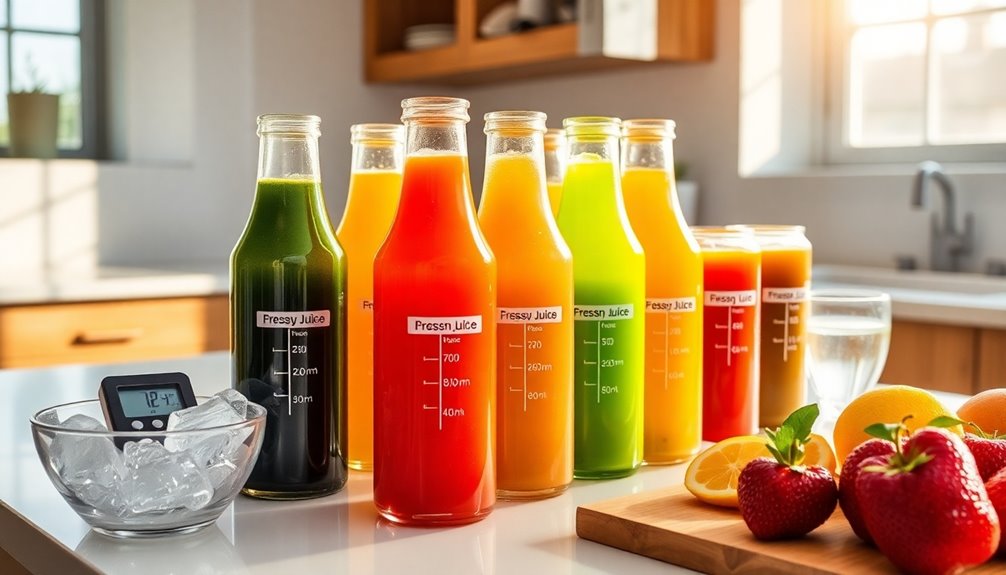
When you want to keep your cold-pressed juices at their best, following a few best practices for storage makes all the difference.
Proper time and temperature management is key to maintaining freshness and extending the shelf life. Here's what you should do:
- Keep Refrigerated: Store juices between 34-40°F for ideal freshness, aiming to consume within 2 days.
- Use Airtight Containers: Minimize air exposure by using airtight containers to protect juice from light and heat.
- Transfer to Smaller Containers: This helps juices cool faster after production, preserving nutrients.
- Check for Spoilage: Regularly inspect for discoloration, off odors, or sedimentation to verify safety.
Additionally, maintaining the right temperature management is crucial for ensuring the preservation of nutrients in your juices.
Following these tips will help you enjoy your juices at their best!
Innovative Ways to Extend Juice Life
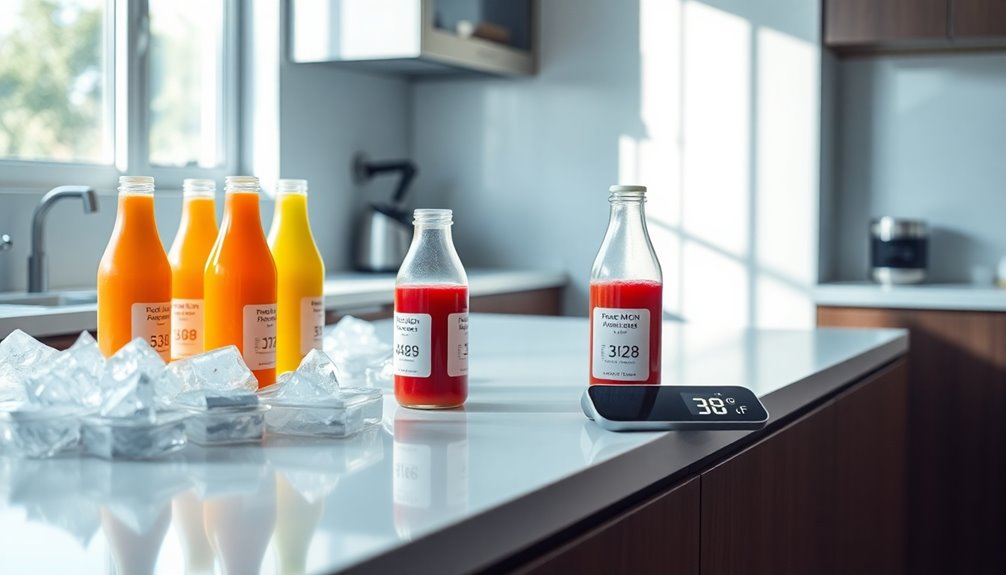
Maximizing the freshness of your cold-pressed juices doesn't stop at proper storage methods. Here are some innovative ways to extend juice life:
| Method | Benefits |
|---|---|
| High-Pressure Processing | Extends refrigerated shelf life by 10+ days |
| Vacuum Sealing | Prolongs freezer life to 1 year |
| Lemon Juice Addition | Adds 3-5 days shelf life without compromise |
| Airtight Containers | Minimizes degradation from light and heat |
| Quick Consumption | Best within 2 days for peak nutrients |
Using high-pressure processing can prevent microbial growth and oxidation, while vacuum sealing keeps your juice fresh for a year. Adding lemon juice not only enhances flavor but also extends shelf life. Store wisely, and enjoy every sip!
Frequently Asked Questions
What Temperature Should Juice Be Stored At?
You should store juice between 34°F and 40°F to keep it fresh and safe.
If you refrigerate it at 40°F or lower, it can last up to 2 days. However, if you leave it at room temperature, try to drink it within 8 hours.
For long-term storage, freezing juice at 0°F or below works too, allowing it to last 6-12 months without losing much quality.
Always keep it sealed tight!
What Are the Best Practices for Safe Temperature Control for Food?
Imagine your food as a delicate flower, needing the perfect environment to bloom.
To keep it safe, you'll want to maintain cold foods at 41°F or lower and hot ones at 135°F or above. Check temperatures every two hours, tossing anything left out for over two.
When cooling cooked dishes, aim for 70°F in two hours and 41°F in six.
Finally, organize your fridge to prevent cross-contamination, ensuring safety blooms!
What Is the Best Way to Store Fresh Juice?
To store fresh juice, keep it in the refrigerator at 40°F (4°C) or lower.
Consume it within 2 days for the best taste and quality.
If you need to store it longer, freeze it in airtight containers for up to 6-12 months.
Avoid crisper drawers and door shelves, as they can fluctuate in temperature.
Always check for spoilage signs, like discoloration or off odors, before drinking.
Enjoy your juice safely!
How Long Can You Keep Juicing in the Fridge?
You can keep cold-pressed juices in the fridge for about 2 days for ideal freshness.
If you've opened a bottle, it's best to drink it within 7-10 days.
Did you know that green juices often last longer than fruit blends?
Storing your juice in airtight containers and maintaining a temperature between 34-40°F will help preserve its quality.
After 8 hours unrefrigerated, though, the nutritional value starts to decline considerably.
Conclusion
To summarize, proper juice storage and temperature control are essential for maintaining freshness and safety. With the right refrigeration and understanding of spoilage signs, you can enjoy your juice longer. So, why risk your health and waste your favorite beverages by neglecting these practices? By following best practices and innovative storage techniques, you can savor every drop of your juice. Keep your drinks cool, and they'll reward you with delicious flavor and extended shelf life!
Cindy thoroughly researches juicing trends, techniques, and recipes to provide readers with practical advice and inspiration. Her writing style is accessible, engaging, and designed to make complex concepts easy to understand. Cindy’s dedication to promoting the advantages of juicing shines through her work, empowering readers to make positive changes in their lives through the simple act of juicing.

